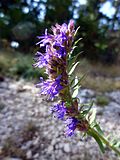Hyssopus officinalis
A perennial herb used in traditional medicine and culinary applications

Hyssopus officinalis, commonly known as hyssop, is a herbaceous plant of the family Lamiaceae, native to Southern Europe, the Middle East, and the region surrounding the Caspian Sea. It is a perennial plant that has been used in traditional medicine and culinary applications for centuries.

Description[edit]
Hyssopus officinalis is a small shrub that grows to about 30 to 60 cm (12 to 24 inches) in height. The plant has a woody stem at the base and produces multiple branches. The leaves are narrow, lanceolate, and dark green, measuring about 2 to 5 cm in length. The plant blooms in the summer, producing small, tubular flowers that are typically blue, although pink and white varieties also exist.
Cultivation[edit]
Hyssop is a hardy plant that thrives in well-drained soil and full sun. It is drought-tolerant and can be grown in a variety of soil types, although it prefers alkaline conditions. Hyssop is often propagated by seed, cuttings, or division. It is commonly grown in herb gardens and is valued for its aromatic leaves and attractive flowers.
Uses[edit]
Culinary[edit]
Hyssop leaves have a strong, minty flavor and are used as a seasoning in cooking. They can be added to salads, soups, and stews, and are sometimes used to flavor liqueurs such as Chartreuse. The leaves can also be used to make herbal teas.
Medicinal[edit]
Traditionally, hyssop has been used in herbal medicine to treat a variety of ailments. It is believed to have antiseptic, cough suppressant, and expectorant properties. Hyssop has been used to relieve respiratory conditions such as asthma, bronchitis, and sore throats. However, its medicinal use should be approached with caution, as it can be toxic in large doses.
Other Uses[edit]
Hyssop is also used in perfumery and as an ornamental plant in gardens. Its flowers attract bees, making it a good plant for pollinator gardens.
Cultural Significance[edit]
Hyssop has a long history of use in religious and cultural rituals. It is mentioned in the Bible as a purifying herb and has been used in various cleansing ceremonies.
-
A Guixers (Solsonès-Catalunya)
-
Port del Comte (Solsonès - Catalunya)
-
Flowers
-
Habitus (as grown in Denmark)
Related pages[edit]
Ad. Transform your life with W8MD's Budget GLP-1 injections from $75


W8MD offers a medical weight loss program to lose weight in Philadelphia. Our physician-supervised medical weight loss provides:
- Weight loss injections in NYC (generic and brand names):
- Zepbound / Mounjaro, Wegovy / Ozempic, Saxenda
- Most insurances accepted or discounted self-pay rates. We will obtain insurance prior authorizations if needed.
- Generic GLP1 weight loss injections from $75 for the starting dose.
- Also offer prescription weight loss medications including Phentermine, Qsymia, Diethylpropion, Contrave etc.
NYC weight loss doctor appointmentsNYC weight loss doctor appointments
Start your NYC weight loss journey today at our NYC medical weight loss and Philadelphia medical weight loss clinics.
- Call 718-946-5500 to lose weight in NYC or for medical weight loss in Philadelphia 215-676-2334.
- Tags:NYC medical weight loss, Philadelphia lose weight Zepbound NYC, Budget GLP1 weight loss injections, Wegovy Philadelphia, Wegovy NYC, Philadelphia medical weight loss, Brookly weight loss and Wegovy NYC
|
WikiMD's Wellness Encyclopedia |
| Let Food Be Thy Medicine Medicine Thy Food - Hippocrates |
Medical Disclaimer: WikiMD is not a substitute for professional medical advice. The information on WikiMD is provided as an information resource only, may be incorrect, outdated or misleading, and is not to be used or relied on for any diagnostic or treatment purposes. Please consult your health care provider before making any healthcare decisions or for guidance about a specific medical condition. WikiMD expressly disclaims responsibility, and shall have no liability, for any damages, loss, injury, or liability whatsoever suffered as a result of your reliance on the information contained in this site. By visiting this site you agree to the foregoing terms and conditions, which may from time to time be changed or supplemented by WikiMD. If you do not agree to the foregoing terms and conditions, you should not enter or use this site. See full disclaimer.
Credits:Most images are courtesy of Wikimedia commons, and templates, categories Wikipedia, licensed under CC BY SA or similar.
Translate this page: - East Asian
中文,
日本,
한국어,
South Asian
हिन्दी,
தமிழ்,
తెలుగు,
Urdu,
ಕನ್ನಡ,
Southeast Asian
Indonesian,
Vietnamese,
Thai,
မြန်မာဘာသာ,
বাংলা
European
español,
Deutsch,
français,
Greek,
português do Brasil,
polski,
română,
русский,
Nederlands,
norsk,
svenska,
suomi,
Italian
Middle Eastern & African
عربى,
Turkish,
Persian,
Hebrew,
Afrikaans,
isiZulu,
Kiswahili,
Other
Bulgarian,
Hungarian,
Czech,
Swedish,
മലയാളം,
मराठी,
ਪੰਜਾਬੀ,
ગુજરાતી,
Portuguese,
Ukrainian







